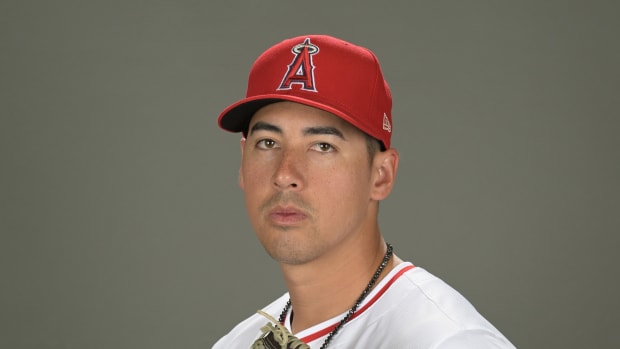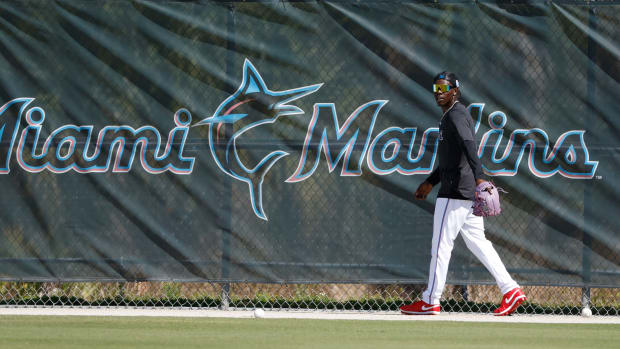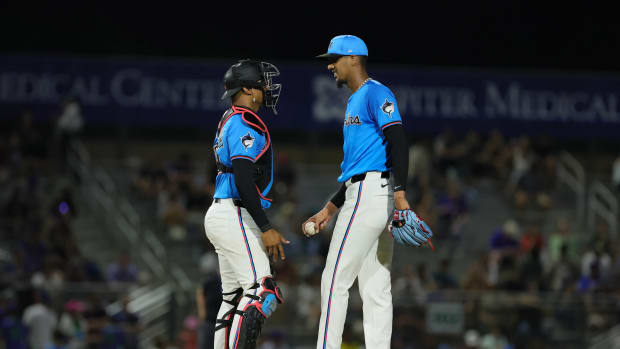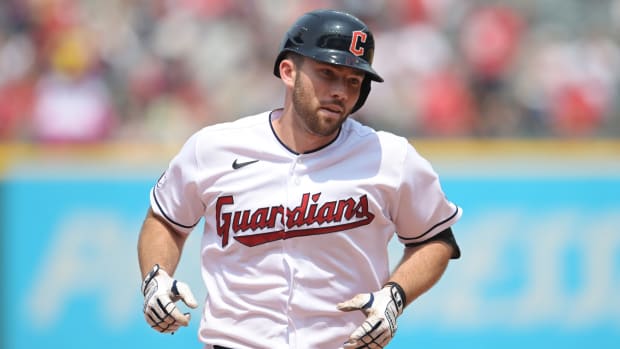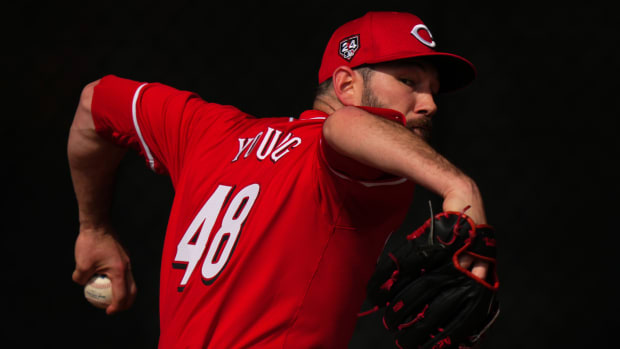Don't Waste This Opportunity to Appreciate Mike Trout
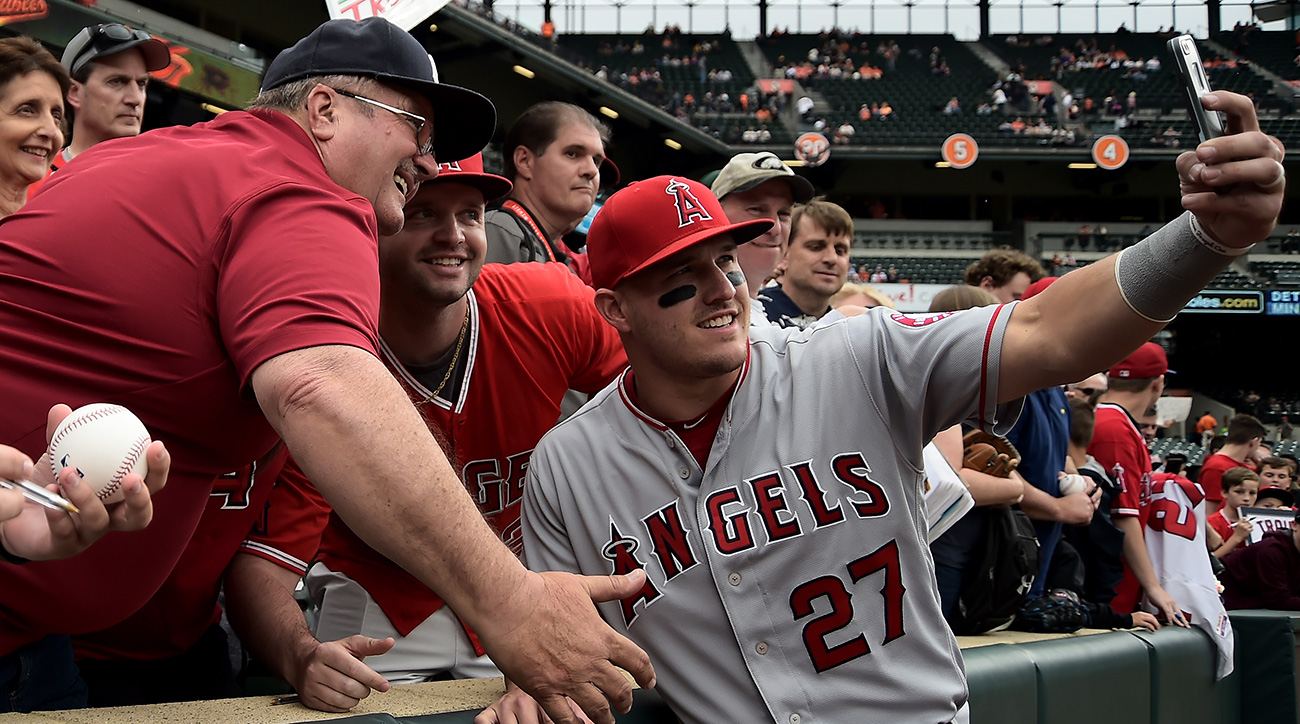
ANAHEIM — It was 12:30 p.m. Saturday, nearly seven hours before the Los Angeles Angels were to play the Kansas City Royals, when Angels coach Mike Gallego stopped in his tracks as he walked through the clubhouse toward a staff meeting. He found it hard to believe that one of the players was already there, and in workout gear.
“What in the world are you doing here?” Gallego asked.
And the best player in baseball, the first man ever to be guaranteed half a billion dollars to play baseball, smiled and said, “I just like it here.”
Mike Trout is a national treasure, and likely the most underappreciated one this side of Gates of the Arctic. His money banked through 2030, Trout still takes each day the same way he did when he was playing high school ball in New Jersey: long, with an honest effort.
That Saturday night Trout signed autographs for kids up to just three minutes before the first pitch, gave his warmup baseball each half inning to kids in the stands, smashed his 250th career home run 473 feet, scored two runs and drew two walks.
With five more stolen bases, Trout will become the youngest of only 40 players to reach 250 homers and 200 steals–by more than a full year over everybody else.
Don’t look now–actually that doesn’t need to be said, because Trout’s Angels remain off the radar with a 22-24 start–but Trout in many ways is better than he’s ever been. For the first time in his career Trout has more walks (41, the most in the majors) than strikeouts (28). He also has career bests in on-base percentage (.471), chase rate (15.4%) and contact rate (86%). He has been on base every game this year but four.
He has played errorless defense while ranking second in the American League in Defensive Runs Saved among centerfielders, trailing only Kevin Kiermaier. He has swiped six bases in seven attempts. His success rate stealing bases (84.8%) is third best all time.
And do you like consistency at an elite level? Trout’s monthly OPS is greater than 1.000 for the seventh time in his past eight months. His on-base percentage is greater than .400 for the 17th time in his past 18 months. (A “slump” for Trout was a .385 OBP in September of 2017.) On Saturday he completed an entire calendar year without failing to reach base in two straight complete games.
“He just loves to play,” said first-year Angels manager Brad Ausmus, when asked what he has learned to appreciate about Trout. “He’s very interested in the intricacies of the game. He’s always looking for ways to get better.
“He genuinely wants to be the best player in baseball in everything that he does. He wants to be the best defender. He wants to be the best baserunner. And he notices little things and will come in off the bases, for instance, and ask, ‘Hey, I saw something. Was that a good time to [run]?’”
Trout has played more than 1,000 career games. He turns 28 in August. It’s easy to believe that Trout is smack in his prime right now. The way he has dropped his chase rate for a fourth straight season is a good indicator that he is combining the wisdom of almost 5,000 plate appearances with his physical peak.
But here’s the rub: As Trout is peaking, his opportunity to take meaningful swings is decreasing.
Take a look at these trends: Trout is getting fewer swings while pitchers throw more balls to him than to any other hitter in baseball:
Trout's Swings Per Game
2019 | 6.14 |
2018 | 6.83 |
2017 | 7.03 |
2016 | 7.26 |
2015 | 7.02 |
Trout's Percentage of Balls Seen
| Percentage | MLB Rank |
2019 | 43.0% | 1 |
2018 | 40.2% | 2 |
2017 | 40.2% | 3 |
2016 | 38.9% | 4 |
2015 | 37.8% | 9 |
Through more than a quarter of the season, Trout has just five hits with runners in scoring position. Five! Yet because pitchers prefer to walk him–yes, even with runners in scoring position–Trout’s on-base percentage with RISP is .571.
Only six hitters in recorded history have reached base at that level over a full season with runners in scoring position: steroid users Barry Bonds, Manny Ramirez and Mark McGwire, and Ted Williams, Mickey Mantle and … Mike Trout last year.
There is a dance that goes on every night between pitchers and Trout. Because he is such a great hitter, pitchers won’t challenge him. And because Trout’s plate discipline is so improved, he won’t bite at their attempt to get him to chase.
The one area of vulnerability Trout has–the top of the strike zone–gives pitchers a lone sliver of hope. But Trout has improved on those pitches by not swinging at them as often–or by crushing the high ones that don’t have enough velocity and/or ride, as he did to the 92 mph four-seamer from Jakob Junis of Kansas City for his milestone homer Saturday, the third longest in baseball this year.
Over the past two years, only two players have hit a ball that far and stolen 30 bases: Trout and Trevor Story.
This says it all about a pitcher’s only hope when daring to challenge Trout in the zone:
Trout vs. Pitches Based on Pitch Height, 2015-19
Location in Strike Zone | Batting Average | MLB Rank |
Top Third | .234 | 172 |
Middle Third | .397 | 4 |
Bottom Third | .386 | 1 |
This dance between pitchers and Trout makes baseball less interesting, like a hardball version of Hack-a-Shaq. Tony Wolters, Mike Tauchman and Dylan Moore have more hits with runners in scoring position than Trout.
Once Shohei Ohtani finds his timing at the plate and Justin Upton returns to the lineup, maybe Trout will get more pitches to hit. Meanwhile, the analytics staff of the Angels has studied where best to bat Trout to maximize his value–First? Second (his spot this year)? Third ? It decided on this conclusion: it doesn’t matter that much.
“The ideal position,” Ausmus said, “is if he batted leadoff and he hit behind himself.”
The Angels know that every spot in the batting order means an extra 17 or 18 plate appearances over the course of the season.
But if you bat leadoff, you are guaranteeing at least 23% of your plate appearances will occur with nobody on base. Batting second may provide a few more plate appearances than batting third, but the risk might be fewer runners on base.
“It’s a debate,” Ausmus said. “But the bottom line is the effect of hitting second or third is not very meaningful.”
Finally, the impact of Trout never will be appreciated unless the Angels win a postseason series. There is no indication that is happening any time soon. Los Angeles starters have just nine quality starts, tied with Baltimore for the fewest in baseball. Their ERA is 5.71, worse than all rotations except the White Sox. Overall, the Angels have finished outside the top five in league ERA every year since Trout’s rookie season.
FiveThirtyEight gives Los Angeles a 7% chance of making the playoffs. An Angels fan can dream on Ohtani, 24, and Griffin Canning, 23, fronting the rotation next year, Ty Buttrey, 26, closing, and a lineup with Trout, 27, Ohtani, and Jo Adell, 20. Maybe, as Trout believes, the franchise is about to turn a corner.
While one player in baseball cannot impact a franchise’s fortunes as greatly as in some other sports, it is unusual that the best player in baseball is 0-for-8 in years trying to win a postseason series in an era in which one out of every three teams goes to the playoffs. (The Angels reached once with Trout, in 2014, and were swept by the Royals.)
Players this good generally win. Nobody in baseball has collected more total bases through his age-26 season without winning a postseason game than Trout:
Most Total Bases Through Age-26 Season
Name | Postseason Wins |
1. Alex Rodriguez | 9 |
2. Mel Ott | 4 |
3. Jimmie Foxx | 11 |
4. Hank Aaron | 7 |
5. Mickey Mantle | 26 |
6. Ty Cobb | 4 |
7. Frank Robinson | 1 |
8. Mike Trout | 0 |
9. Vada Pinson | 1 |
10. Orlando Cepeda | 3 |
The losing and lack of pitches to hit never appear to throw Trout. Similarly, half a billion dollars banked doesn’t keep him from getting to the park seven hours before game time with a smile on his face. He simply rolls on, happily, consistently, and all too quietly. He is our Mickey Mantle, but Mantle without October.
































